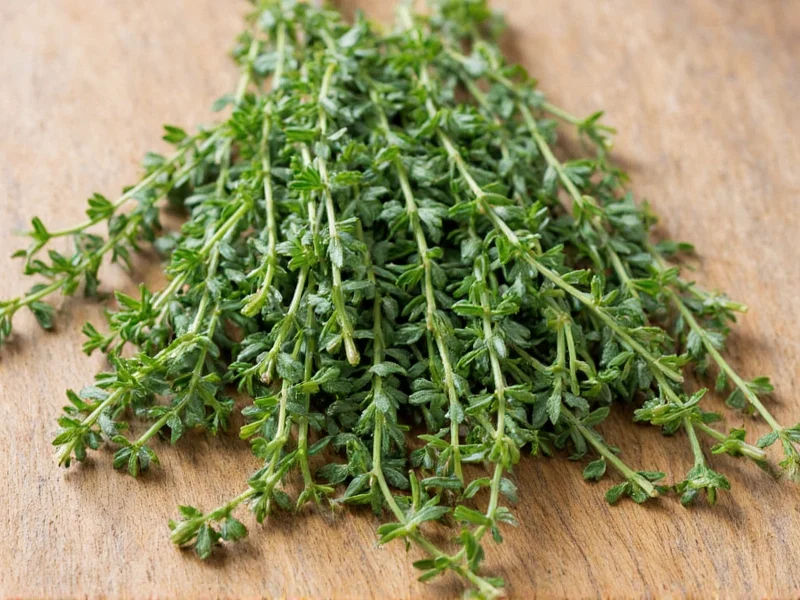Understanding herb conversions is essential for achieving balanced flavors in your cooking. When substituting dried thyme for fresh (or vice versa), getting the measurements right can mean the difference between a perfectly seasoned dish and an overpowering one.
Why Dried and Fresh Thyme Have Different Potencies
Thyme undergoes significant chemical changes during the drying process. As moisture evaporates, the essential oils and flavor compounds become more concentrated. Fresh thyme contains approximately 70-80% water, which dilutes its aromatic compounds. When dried, this water content drops to about 10-15%, resulting in a much more intense flavor profile by volume.
The concentration process explains why you need less dried thyme than fresh to achieve equivalent flavor impact. This isn't unique to thyme—most dried herbs follow a similar 1:3 ratio when substituting for fresh versions.
Dry Thyme to Fresh Thyme Conversion Chart
| Dried Thyme | Fresh Thyme Equivalent | Best Used For |
|---|---|---|
| ¼ teaspoon | ¾ teaspoon | Delicate sauces, dressings |
| ½ teaspoon | 1½ teaspoons | Vegetable dishes, light soups |
| 1 teaspoon | 1 tablespoon | Standard conversion for most recipes |
| 1½ teaspoons | 4½ teaspoons | Heartier stews, braises |
| 2 teaspoons | 2 tablespoons | Robust meat dishes, long-cooking recipes |
When to Use Dried Versus Fresh Thyme
Understanding when to use each form of thyme enhances your cooking results beyond simple measurement conversions:
Best Applications for Dried Thyme
- Long-cooking dishes: Stews, braises, and soups benefit from dried thyme's concentrated flavor that withstands extended cooking times
- Dry rubs: Dried thyme adheres better to meats and integrates more effectively with other dry spices
- Winter cooking: Complements hearty, robust flavors typical of colder months
- When fresh isn't available: Provides consistent flavor year-round
Best Applications for Fresh Thyme
- Finishing dishes: Adds bright, aromatic notes when sprinkled on just before serving
- Delicate preparations: Ideal for salad dressings, light sauces, and seafood dishes
- Visual presentation: Whole sprigs make attractive garnishes
- Short-cooking recipes: Preserves its more nuanced flavor profile
Practical Substitution Tips for Home Cooks
When converting between dried and fresh thyme in your recipes, consider these practical tips:
- Start conservatively: When substituting dried for fresh, begin with ⅔ of the recommended amount and adjust to taste
- Timing matters: Add dried thyme early in cooking to allow flavors to distribute, while fresh thyme works best added in the last 10-15 minutes
- Leaf removal: Strip fresh thyme leaves from stems before measuring for accuracy—stems add volume without flavor
- Taste as you go: Especially when substituting, taste your dish periodically to avoid over-seasoning
- Consider the dish type: For delicate dishes like fish or egg preparations, use slightly less dried thyme than the standard ratio suggests
Storage Recommendations for Optimal Flavor
Proper storage extends the shelf life and maintains the potency of both thyme forms:
Storing Dried Thyme
Keep dried thyme in an airtight container away from light and heat. Properly stored, it maintains peak flavor for 6-12 months. After one year, potency gradually diminishes—use older dried thyme more liberally or replace it entirely.
Storing Fresh Thyme
Wrap fresh thyme sprigs in a slightly damp paper towel and store in a perforated plastic bag in the refrigerator's crisper drawer. This method preserves freshness for 10-14 days. Alternatively, place stems in a glass with an inch of water (like flowers) and cover loosely with a plastic bag.
Common Questions About Thyme Substitutions
Many home cooks encounter specific challenges when working with different thyme forms. Understanding these nuances helps achieve better results in your cooking.
Can I substitute dried thyme for fresh in a 1:1 ratio?
No, substituting dried thyme for fresh in a 1:1 ratio will result in an overpowering, potentially bitter flavor. The correct dry thyme to fresh thyme conversion is 1:3—use one-third the amount of dried thyme compared to fresh. For example, if a recipe calls for 1 tablespoon of fresh thyme, use only 1 teaspoon of dried thyme.
Does the quality of dried thyme affect the conversion ratio?
Yes, the age and quality of dried thyme impacts its potency. Freshly dried thyme (within 6 months) follows the standard 1:3 ratio. Older dried thyme (6-12 months) may require using up to 50% more to achieve equivalent flavor. Very old dried thyme (over 12 months) often loses significant flavor and may not provide satisfactory results regardless of quantity.
How do I adjust thyme measurements for frozen thyme?
Frozen thyme behaves more like fresh than dried thyme. Use a 1:1 ratio when substituting frozen for fresh thyme. If replacing dried thyme with frozen, use three times the amount of frozen thyme. For example, 1 teaspoon dried thyme equals 1 tablespoon frozen thyme. Thaw frozen thyme before using for most accurate measurement.
Why does my dish taste different when I substitute dried for fresh thyme?
Dried and fresh thyme contain slightly different flavor compounds due to the drying process. Drying concentrates certain compounds while diminishing others, creating a more intense but less complex flavor profile. Dried thyme emphasizes earthy, woody notes, while fresh thyme offers brighter, more floral characteristics. This explains why even with proper measurement conversion, the flavor profile may differ slightly.
Can I make my own dried thyme from fresh?
Yes, you can easily dry fresh thyme at home. Bundle sprigs together and hang them upside down in a warm, dry, dark place for 1-2 weeks. Alternatively, spread leaves on a baking sheet and dry in the oven at the lowest setting (150-170°F) for 2-4 hours. Properly dried thyme should crumble easily. Store in an airtight container away from light. Home-dried thyme typically follows the standard 1:3 conversion ratio when substituting for fresh.











 浙公网安备
33010002000092号
浙公网安备
33010002000092号 浙B2-20120091-4
浙B2-20120091-4